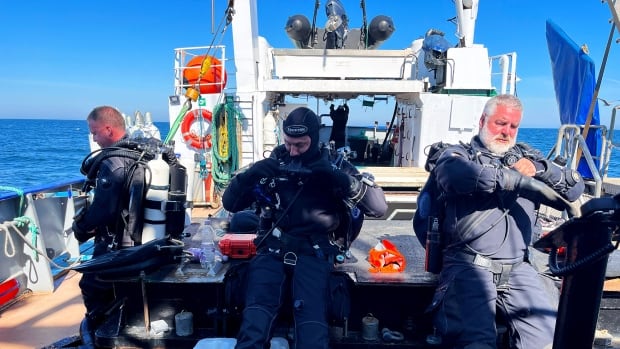It was an event that rocked Europe and shook world affairs.
Early in the morning on Sept. 26, 2022, a series of powerful undersea explosions damaged pipelines under the Baltic Sea near Denmark that carried Russian natural gas to Germany.
Fingers were immediately pointed at Ukraine, which had been at war with Russia since the latter invaded in February of that year. Ukraine denied involvement, and in the absence of reliable information, conspiracy theories proliferated about who attacked the Nord Stream pipeline.
Did a Russian submarine intentionally destroy it in order to cut off the gas supply to Germany, a country allied with Ukraine? Was it the CIA, as famed U.S. investigative journalist Seymour Hersh wrote?
The German government has been tightlipped about the affair for two years, but this week, German media outlets ARD, Sueddeutsche Zeitung and Die Zeit jointly reported that federal prosecutors obtained an arrest warrant against a Ukrainian man. A Polish government spokesperson confirmed it.
The German reports identified the man as Volodymyr Z., a diving instructor who last resided in Poland. In a brief telephone conversation on Tuesday with reporters from ARD, Sueddeutsche Zeitung and Die Zeit, Volodymyr Z. expressed surprise at the accusations and denied involvement.

A report this week by the Wall Street Journal also pointed to Ukraine, suggesting the operation was carried out by Ukrainian soldiers and civilians with diving expertise and under the direction of Ukraine’s then-commander-in-chief, Valerii Zaluzhnyi.
Journalists at ARD, Germany’s public broadcaster, have been hot on the trail since the shocking explosions took place. I was one of the reporters who was part of the team that spent months piecing together what may have occurred.
To understand what happened to the Nord Stream pipeline that day, ARD chartered the very yacht the perpetrators allegedly used and sent divers into the roiling waters of the Baltic Sea to see how the pipeline might have been attacked.
Group chartered sailing yacht
Several outlets have reported that in early September 2022, a sailing yacht called Andromeda set sail from the port of Hohe Düne in Rostock, Germany. According to the ARD investigation, the commando that was to destroy the pipelines was on board the Andromeda. The group is said to have consisted of six people — five men and one woman. Among them, it is suspected, was Volodymyr Z.
After stops in Rügen, Bornholm and Christiansø in Denmark, Sandhamn in Sweden and Kołobrzeg in Poland, the boat returned to Rostock.

At some point during the trip, investigators believe the crew dove from the yacht down to the seabed and, in the darkness of the Baltic Sea, attached the explosive devices to the pipeline at a depth of around 80 metres.
What happened later is well-known. At 2:03 a.m. local time on Sept. 26, 2022, the first explosion damaged Nord Stream 2. Approximately 16 hours later, three other explosions damaged Nord Stream 1. Investigators later found residue of the explosive HMX, also known as octogen, on board the Andromeda.
During our investigation, we wondered just how hard it would have been to carry out such a mission.
The Andromeda is a charter yacht. Anyone can rent it — so we rented it, too, and took three divers with us.
As with many charter yachts, the Andromeda was not in the best condition — our skipper called it “one of the worst boats I’ve ever sailed with.”
He said several electrical components were broken and that the yacht didn’t move well in the waves. Then there was the swim platform, which the divers would need to get on and off the boat. If the swell is high, the platform moves up and down, punching into the sea. A diver trying to get back on the boat could be slammed on the head by the platform, causing serious injury. For us, this risk was too high.

So we returned the Andromeda and chartered a professional diving vessel with a crew that usually recovers Second World War explosives from the bed of the Baltic Sea.
We then drove to the exact spot where the first explosion happened — 120 kilometres off the German coast, with the Danish island Bornholm in sight.
Trained divers required
We arrived at 6 a.m. to witness a symbolic moment in the Baltic Sea.
A Russian military ship appeared. Through our radio, we heard, “Russian warship delta echo, U.S. warship Yankee.” The U.S. Navy was trying to make contact with the Russian Navy right before our eyes. How could a sabotage operation have gone on undetected in this environment?
The burst pipeline lay almost 80 metres beneath us, a depth not every diver could handle.
You need to be trained as a tech diver. At that depth, you have to breathe a special mixture of oxygen, helium and nitrogen, and that means carrying about 220 pounds of equipment.

It is also pitch black at the bottom of the sea. The multiple scuba tanks gave the divers about 40 minutes to find the pipeline, which means they needed to know precisely where to look. A sonar device was required to locate the pipeline beforehand. The Andromeda did not have this kind of device on board, but our new vessel did.
Our tech divers found the burst pipeline on their second try and filmed it.
The difficult part for the divers was returning to the surface. The pressure is so intense that if the ascent is not done correctly, divers could experience serious symptoms like paralysis or damage to their lungs. Doing proper decompression from such a depth — which requires divers to switch to a different gas mix — takes about two hours.
Conducting a complex mission like that from the Andromeda would have been difficult and dangerous. According to the German investigation, it’s plausible Volodymyr Z. was trained for dives like that.

Everyone who has examined the Andromeda agrees it’s not the vessel anyone would choose to secure a mission.
As our tech diver Derk Remmers put it: “I would use the Andromeda for a vacation, but not a sabotage mission.”
Yet this could be precisely why the saboteurs used it. To stay undetected and unaccountable — which they managed to do until the charges were made public this week.




